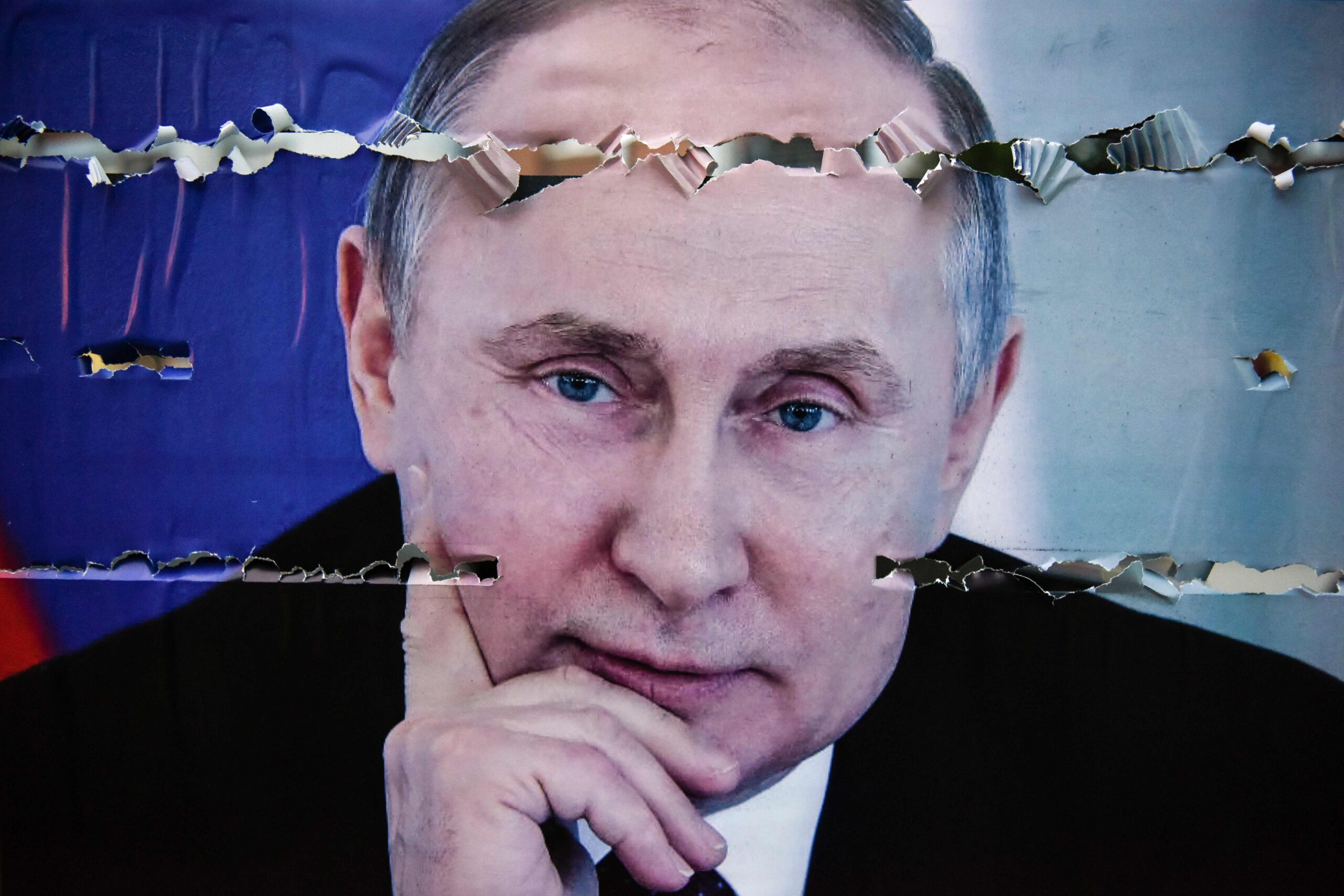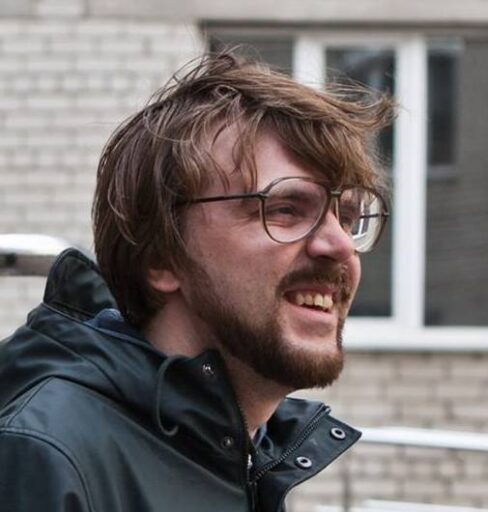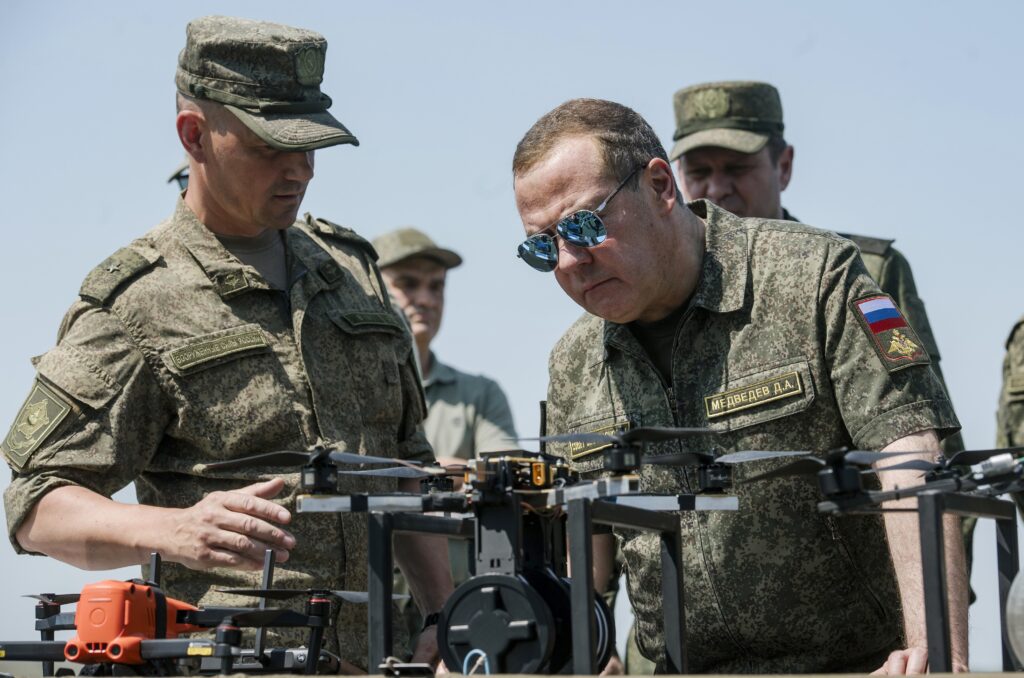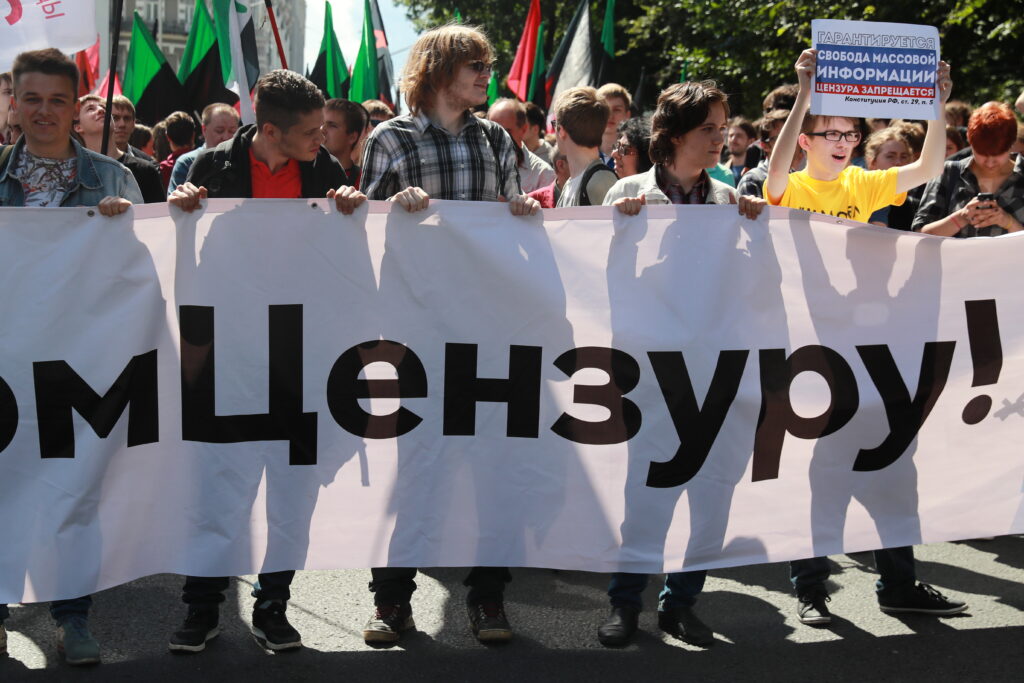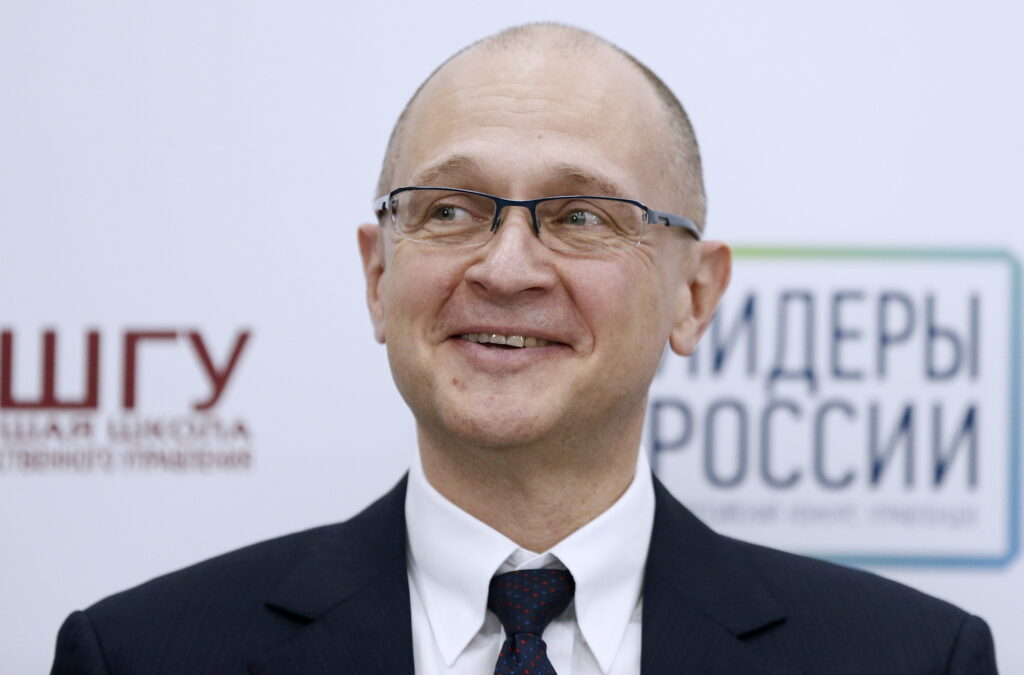Russia’s invasion of Ukraine, the course of hostilities and the reaction of the Russian authorities and ordinary citizens to the invasion have proved that the stability of Putin’s regime is a mythical construct. In the space of a few months, the five main myths on which the image of Putin’s state was founded have been consistently undermined and almost entirely stripped away. The facade of the regime is built of a powerful army, a monolithic power vertical, skilful propaganda that can indoctrinate citizens with anything the Kremlin wants, the militarisation of much of society and the active support of that society for any of Putin’s undertakings. The Kremlin has conveyed these myths to both external and internal audiences. By going to war in Ukraine, the Putin regime tried to be what it pretended to be, but its facade crashed into reality. Of course, the system is still holding on: Russians still see no alternative to Putin; they fear a return to the ‘roaring 1990s’ while the budget is replenished by the sale of hydrocarbons. But it is the core of the regime, not the trappings, which has undergone erosion.
The image of Putin’s Russia — for both international and domestic audiences — was built on five pillars. The Kremlin spared no effort to prove to Russians and to other states that it had a powerful modern army capable of standing up to any other army in the world. Putin’s power vertical is effective and managed personally by the president, and its constituent parts (the siloviki, officialdom and state-affiliated businesses) act in concert. Society is ready to support any undertaking of the president, to endure hardship for his sake. These three components of the regime’s image were intended for both external and internal audiences loyal to the authorities. The latter had to and did develop a sense of calm and confidence in the future. The former had to be assured that the Kremlin was in control of the situation inside Russia and was ready to strike back should external enemies think of trying to change Russia’s leadership.
Two other messages were aimed rather at foreign leaders and at Russians who were critical of Putin and his regime. One of the messages implied the omnipotence of official propaganda, which can convince the population of anything and encourage people to do anything. The other emphasised the militarism of Russian society, which was apparently ready and internally mobilised to use force to protect the government. These messages, too, were meant to prove that there was no point in ousting Putin or hoping for his departure. Russians are standing up for Putin, they will fight for him, and if they start to doubt anything, the propaganda will quickly get them back on track. Russia’s war against Ukraine, the situation on the front line, mobilisation and society’s attitude to all these things proved that these are just propaganda myths the artificiality of which has become clear in a time of crisis.
Myth 1 — a mighty army
The myth of a powerful Russian army which seemed super-efficient and modern even to Putin himself was the first to be dispelled. If the Russian president had been even partly aware of the shortcomings of his own armed forces, he would have been unlikely to launch a full-scale war against a large state. Defence Minister Sergei Shoigu and his subordinates knew how to construct an image of a super-efficient structure even when Shoigu worked in the Ministry of Emergency Situations. The Defence Ministry regularly reported on new weapons that Putin threatened the US with on the eve of the 2018 presidential election. The Ministry organised large-scale events — military drills in and outside Russia, tank biathlons and forums to demonstrate and sell military equipment and vehicles. The president personally participated in many of these events. The Russian leadership clearly hoped for a blitzkrieg: it was assumed that the Russian army was in excellent condition, the Ukrainian army was not at its best, the Ukrainian leadership was demoralised and the Ukrainian population would greet the Russians with flowers. As regards the latter two assumptions, the Kremlin was persuaded by the security services. It is likely that if Putin and the siloviki had based their invasion plans on information about the real state of the Russian army, the war might have played out in a different manner. However, the decisions were made based on the window-dressing, as the armed forces were perceived as powerful enough to carry out a blitzkrieg. The Kremlin and the army were unable to adjust to reality immediately; for a long time Putin himself and his Kremlin representatives maintained that only contracted professional soldiers were sufficient for Russia to win. The Russian authorities could have changed their tactics and declared any random outcome of the invasion a victory, as they had never set clear goals for the war. But again they did not do this. The Russian army outed itself in summer and autumn, betraying its true condition.
In a few months of the war, it has become clear that the Russian army does not have much top-notch military equipment or vehicles — some of them damaged or obsolete — and that its stocks of missiles are being gradually depleted. Arms manufacturers are now upgrading obsolete T-62 tanks. The Russian army’s offensive quickly ran out of steam, and by autumn the Armed Forces of Ukraine had begun to squeeze Russian troops out of captured territory. It turned out that the relatively successful actions of Russian troops in Syria far from guaranteed the same success in battles with a large regular army. The professionalism of the generals was brought into question. Ultra-patriots, who had long admired the Russian armed forces and their leadership, began to criticise them just as ardently; as we are well aware, disappointed fans make the most outspoken critics. The Russian armed forces hardly make anyone’s blood run cold now, though of course their nuclear weapons are still feared by many. Mass conscription has only twisted the knife in the image of an effective army. On top of that, there are no uniforms at the depots, and servicemen and their families have to buy uniforms themselves, which demonstrates the condition of the Russian armed forces (and most Russian citizens know someone who has been conscripted).
Myth 2 — an efficient power vertical
The war shattered the myth of Putin’s power vertical, yet another seemingly efficient and well-oiled Russian machine. It was assumed that the president controlled his subordinates, who cooperated closely with one another and delivered on their commitments to the head of state. In practice, however, this is not the case. Even the siloviki are in conflict with one another, and they certainly do not want to act in concert with civilians. Members of the president’s inner circle or their avatars in the Presidential Administration or the government lobby for decisions that benefit themselves, not the regime as a whole, and are willing to depart from the interests of the vertical. Putin is no longer giving a heads-up to his subordinates about his key decisions, and, as a result, they are being implemented in an emergency manner and in an atmosphere of chaos and misunderstanding. Naturally, Russian citizens are bewildered or even horrified by this chaos (‘Where is Putin’s power vertical with its clear logic of action?’).
The already-mentioned draft, which was announced in late September, is the best example of the dismantling of the myth of an efficient power vertical. The announcement of mass conscription clearly came as a surprise to most of those called on to implement it. The political bloc had not prepared the ground in any way; a few days earlier, Kremlin officials had assured the public that there would be no national conscription and that there was no need for it. Military registration and enlistment office personnel were also unprepared for it, as they began chaotically sending out conscription notices and conscripting men at random in fear of not being able to deliver. Fathers with many children and men who had never served in the army were drafted while hearing official statements that only men with ‘combat experience’ would be conscripted. The decision, which was unpopular from the start, was also implemented in the worst possible way, and attempts to work out the kinks, to name and shame those responsible, only highlighted the failure of the power vertical. The system, which should have been operational in an emergency, failed. Yes, conscription is ongoing, but military enlistment offices are chasing anyone they can get their hands on. More often than not these are not men who have served in the army and have combat experience but middle-aged residents of provincial towns and villages. IT specialists, teachers and physicians are being mobilised, and even fairly high-ranking officials are being killed in the war. It turns out that the power vertical is indeed oriented towards the orders of its superiors and carries them out at any cost, but it does so in a completely haphazard manner, with plenty of losses, mistakes and contradictions.
Moreover, the power vertical itself is coming apart at the seams, which has been made public. The most active members of the ‘party of war’, Ramzan Kadyrov and Yevgeny Prigozhin, have criticised the Ministry of Defence for both military defeats and the flawed mobilisation. State Duma deputies, inspired by speaker Vyacheslav Volodin, have also expressed their discontent with the military. Via loyal media outlets, the Ministry of Defence has accused them of destabilising the situation and playing into the hands of the enemy. The cacophony of voices has replaced the expected unison of officials, the siloviki and politicians.
Myth 3 — omnipotent propaganda machine
The effectiveness of another of Putin’s trump cards, the powerful propaganda machine, has been greatly undermined. It was well oiled as long as citizens were not facing serious economic difficulties and the Kremlin demanded relatively little from them — for example, to endorse election results, to refrain from protesting and at least to pretend to support the government. Many Russians were happy to repeat propaganda about ‘fascist Ukraine’, ‘Banderites’, ‘Anglo-Saxons’ and the horrors of life in the West, without giving them much thought. This is how people start singing catchy tunes which are constantly broadcast on radio and television. However, at a critical moment for the authorities, the moment of mobilisation, it turned out that many people who had been listening to the tunes were not ready to die for them. They can talk about fascist Ukraine or the rotten West in a rented flat in Kazakhstan, Turkey, Armenia or Georgia rather than at a military enlistment office in Russia. In addition, Russians have proved unprepared for the endless propaganda inflation. Beginning in spring, state TV had broadcast geopolitical talk shows nearly non-stop until TV ratings plummeted, and the Kremlin had to put entertainment programmes back on the air. An attempt by the presidential administration to create a new pro-war Z-pop culture failed. To an outside observer, it is now clear that Putin’s propaganda is not a means of mobilising citizens to actively support the government (like, for example, propaganda in Nazi Germany) but at best a means of diverting attention from the faults of the country’s leadership. It becomes really absurd when propagandists start calling on anonymous officials to ‘stop lying’. In this simple way they are trying to meet the demand of viewers who have lost interest in state media outlets against the backdrop of unpopular decisions by the authorities and escalating questions about disinformation. So far, the pro-government journalists have not named the people they are addressing, but the more the government’s ratings and TV audiences shrink, the more precise and targeted the propagandists will become.
Myth 4 — rampant militarisation of society
On the whole, the militarisation of Russian society has also turned out to be a myth. Some Russian citizens really do not mind dressing their child up in a sham military uniform and putting them in a DIY paper tank, placing a ‘We can repeat’ sticker on their car, putting on camouflage, calling the Defence Minister the most popular politician and the army the most trustworthy institution. This militarised part of society is ready to support the ‘special operation’ with the hands of contracted professionals, vaguely suspicious of its real progress, and to think that information about atrocities in Bucha and Izium was faked by Ukraine and NATO. The ‘militarised’ Russians are clearly in no hurry to put on camouflage and head to the trenches. They have lined up in huge queues at the borders, not at military recruitment stations. The number of Russians who have left the country since the beginning of mobilisation has reached about 700,000. The Ministry of Defence has reported about 200,000 conscripts.
The discrepancy between these figures speaks volumes about the real militarisation spirit, a myth which the Kremlin has really benefited from. It might have seemed that the Russian leadership was ready to call to arms a huge army of motivated fighters. They believed that the people were ready to fight for Putin, and patriotic Russians were convinced that their neighbours or colleagues at work would definitely be in the trenches for the president. The pictures of queues at the borders have dispelled all illusions, as even the inhabitants of remote areas, which were considered the president’s stronghold, have fled into the woods to escape the mobilisation.
Myth 5 — unconditional support for whatever Putin does
Finally, the myth of the cult of personality in Russia has begun to crumble. It was believed that Russians were ready to put up with any decision by Putin and support him no matter what, trusting the president with their future. In the wake of mass conscription, the anxiety level of citizens rose precipitously, and the president’s ratings began to fall. The Kremlin cannot and, it appears, will not be able to improve the sentiments of Russians. Citizens may indeed declare that they are prepared to support their president against all odds, but they declare this only as long as no sacrifices have to be made. As soon as the president crosses red lines, his support begins to fall. According to opinion polls (bearing in mind that the polls are taking place at a time of war), an increasing number of Russians admit that they would revoke the decision to launch the ‘special operation’, and the number of supporters of peace talks is growing. And it is not just about draft; people are also experiencing the effects of the economic sanctions and the drop in living standards. The trends are obvious, and soon Russian society will start looking for a scapegoat. For a while people may be satisfied with ritual sacrifices such as the dismissal of officials from the Ministry of Defence or employees of other government agencies who allegedly could not cope with difficulties. To conclude, citizens will inevitably have to contact the ‘commander-in-chief’ himself. Russians love Putin not for his charisma but for the stability he guarantees, or the illusion of it, such as an acceptable standard of living, the authorities’ more or less predictable actions and, finally, his non-interference in the affairs of ordinary citizens who do not get involved in politics. Support for ‘Putin’ is support for all of the above, not adoration for a man who was born in St Petersburg 70 years ago.
Any myth is effective as long as its creator does not allow it to clash with reality. Skilled myth-makers know this well and guard their creations, and they do not, of course, believe in their own myths. Putin observed these rules for a long time, but he gradually began to believe in the myths that he and his entourage created and then to act in accordance with them. The result has turned out to be quite logical: we are looking at a new image of the regime — its real image. That regime has failed to create an effective army, a propaganda machine or a militaristic society. The Kremlin’s threats, excluding nuclear, are no longer taken seriously. The macho man, flexing his muscles, has quickly turned into an amateur hustler.
